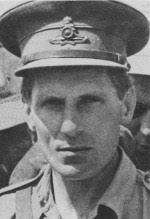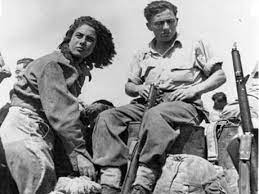THE ORIGINS OF "GRANDMA'S ARMY" - III
THE ORIGINS OF “GRANDMA’S ARMY” - III
Arab riots in Palestine
in 1920 and 1921 strengthened the view that it was impossible to depend upon
the British mandate. The Palestinian Jews felt the necessity to create an
independent defense force completely free of foreign authority. In June 1920,
the Haganah, as an underground military organisation, was founded.
During the first nine years of its existence, the Haganah
was a loose organization of local defense groups, in the large towns and
several of the settlements. The Arab riots in 1929 brought about
a complete change in the Haganah’s status:
- It
became a large organization, encompassing nearly all the youth and adults
in the settlements, as well as several thousand members from each of the
cities.
- It
initiated a comprehensive training program for its members, and ran
officers’ training courses.
- Established
central arms depots into which a continuous stream of light arms flowed
from Europe.
- Simultaneously,
the basis was laid for the underground production of arms.
During 1936-1939 - the years of the Arab revolt - were the years in which the Haganah matured and developed from a militia into a military body. Although the British administration did not officially recognise the organisation, the British Security Forces cooperated with it by establishing civilian militia. In the summer of 1938, Special Night Squads were established, under the command of Captain Orde Wingate.
During the years of the riots, the Haganah protected
the establishment of more than 50 new settlements in new areas of the
country. As a result of the British government's pro-Arab policy - expressed in the blatantly anti-Semitic White Paper of 1939 - the Haganah
supported illegal immigration. It also organised
demonstrations against the British anti-Zionist policy.
At the same time, the Haganah
further strengthened its independence during WWII. A systematic program
of training was instituted for the youth of the country. In 1941, the Haganah’s
first mobilized regiment, the Palmach, came
into being.
At the end of the war, it became clear that the British government had no intention of altering its anti-Zionist policy. The Haganah began an open, organized struggle against British Mandatory rule, in the framework of a unified Jewish Resistance Movement - consisting of all political parties. In its most spectacular operation, the combined forces sabotaged British railways throughout Palestine on the "Night of the Railways".
The Haganah did not function
only in Palestine.
It had branches in other parts of the world, including the United States, Poland, Germany, Italy, France,
and Morocco.
Officers trained tens of thousands of
new immigrant recruits in training camps in Europe and North Africa, even
before they immigrated to Israel -
including many Holocaust survivors. Haganah
branches were also established at Jewish displaced persons' camps in Europe. Thousands of volunteers from Western Europe, North America and South Africa were recruited.
The Palyam,
a marine branch of the Palmach, was given responsibility for
commanding and sailing the ships recruited for illegal immigration. Between
1945-1948, 66 clandestine immigrant ships carrying 85,000 immigrants sailed
to Palestine.
A turning point in
the Haganah's effort to save Jewish immigrants was when the British
seized the EXODUS, 1947 illegal immigration ship - forcing thousands of
Holocaust survivors, seeking refuge in the Land of Israel - to go back to
Europe. This incident was covered heavily in the media. Members of the United
Nations Special Committee on Palestine (UNSCOP) witnessed the event, influencing them to recognize the necessity of a
state for the Jewish People.
Haganah operatives purchased large quantities
of arms from the United States, Western Europe,
and Czechoslovakia,
and sent them to Palestine.
They also founded a weapons industry, TAAS. On the eve of independence, TAAS
owned 46 factories. They manufactured
submachine guns, mortars, grenades, bullets and explosives.
Between 1920 and
April 1949, 5,151 members of the Haganah were killed, 3,952, of whom
died fighting in the War of Independence in 1948.




Comments
Post a Comment